Tabebuya, one type of flowering tree with extraordinary appeal, especially because of its colorful flowers. In Indonesia, tabebuya plants are increasingly popular because they can beautify the surrounding environment with the visual of its flowers that are almost similar to cherry blossoms.
With its striking flower colors such as pink and yellow, tabebuya presents a natural and refreshing atmosphere when planted in our environment. This article will discuss in more detail about the tabebuya tree, the beauty of its flowers, and its contribution to beautifying the environment.
Getting to Know the Tabebuya Tree
Tabebuya comes from the abbreviation “tacyba bebuya” which means “Ant Wood” which is likened to a collection of ants living in hollow branches. According to research from Science Direct , Tabebuya has the scientific name Tabebuia but in Indonesia this tree is often called tabebuya. Tabebuya is a type of tree that is included in the genus Bignoniacaeae, a family of flowering plants in the form of shrubs, trees or plants that grow in tropical and subtropical areas. Tabebuya has characteristics in the form of large flowers, bright colors and almost resembles a trumpet shape. At first glance, the tabebuya tree is similar to the cherry blossom tree from Japan. But actually these two trees are different.
This tabebuya plant is actually found in China but originates from South America. The Bignoniacaeae family is often used as an ornamental plant and various traditional medicines. Because the characteristics of its flowers are almost similar to cherry blossoms, this plant is often referred to as “Brazilian Cherry Blossoms”.
Characteristics of Tabebuya Tree
For those of you who often call this tree cherry blossom, know the various characteristics of the tabebuya tree below to find out its traits and characteristics.
- Tree Height: Tabebuya trees can grow to around 8-10 meters in length, making them a great choice for shade trees or simply as decoration in residential, urban or campus environments.
- Tabebuya Leaves: If observed closely, the leaves of the tabebuya tree are dark green, and pinnate with a medium size. The leaves are quite dense so that they give a natural impression.
- Tabebuya Flower : Tabebuya flower has a trumpet-like shape and has several types of colors such as pink and yellow. This flower usually blooms in September – January.
Difference between Tabebuya and Sakura
Tabebuya and Sakura are often equated by most Indonesian people. In fact, both have several differences in certain aspects. Here is the discussion
Origin
Tabebuya: the tabebuya tree originates from South America and grows in tropical and subtropical areas such as Brazil.
Sakura: Sakura originates from Japan and grows abundantly in East Asian regions such as China and Korea.
Flower Shapes
Tabebuya: Tabebuya has a flower shape that resembles a trumpet, this flower shape is what often makes people compare it to cherry blossoms.
Sakura: Sakura has a flower shape consisting of five petals. The texture of this flower is also smoother and more fragile than tabebuya.
Season
Tabebuya: Tabebuya trees will flower in the dry season, but often this plant blooms in September – January. This flower also lasts longer to bloom until it finally falls.
Sakura: Sakura blooms in spring, around March – April in Japan. Sakura flowers fall faster than tabebuya, lasting only about 1-2 weeks.
Climate
Tabebuya: Tabebuya will thrive in areas with tropical or subtropical climates. This is the reason why this flower is suitable for planting in Indonesia, which is a tropical country.
Sakura: Sakura grows well in temperate climates such as Japan, Korea and Taiwan.
Leaf Characteristics
Tabebuya: Tabebuya trees have leaves even when in contact. Where the leaves tend to be green all year round.
Sakura: different from sakura whose leaves will appear when the flowers have fallen. The size of the leaves on sakura is also smaller than tabebuya.
Types of Tabebuya Flowers
There are various types of Tabebuya flowers with soft and attractive colors to look at. Tabebuya has several flower variants with different colors, including:
Pink Tabebuya Flower
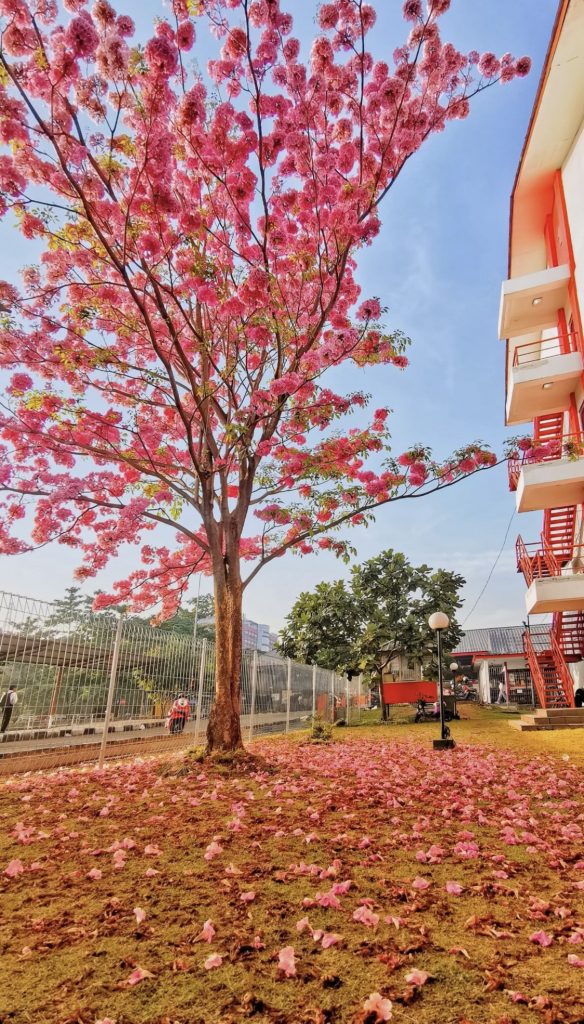
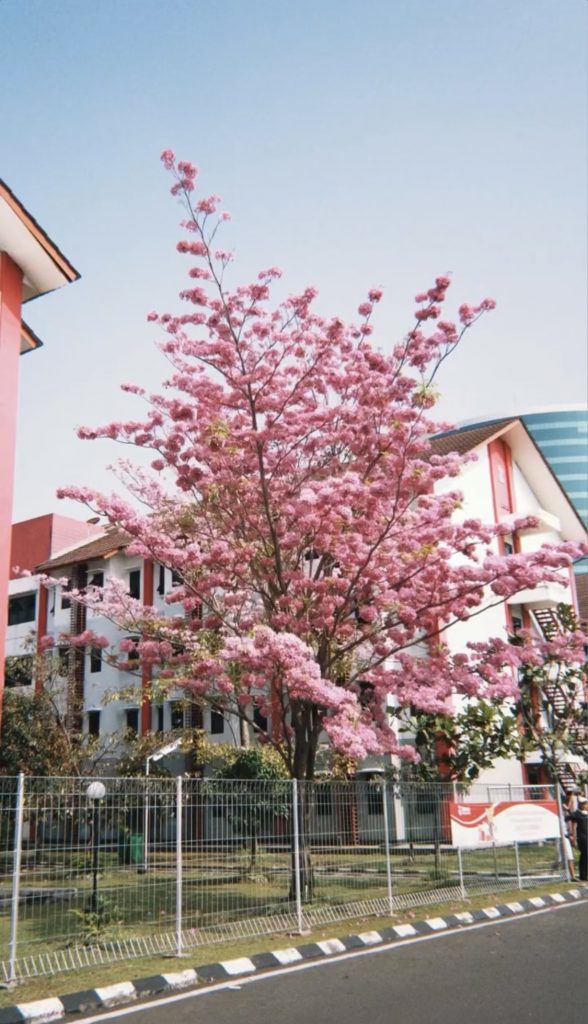
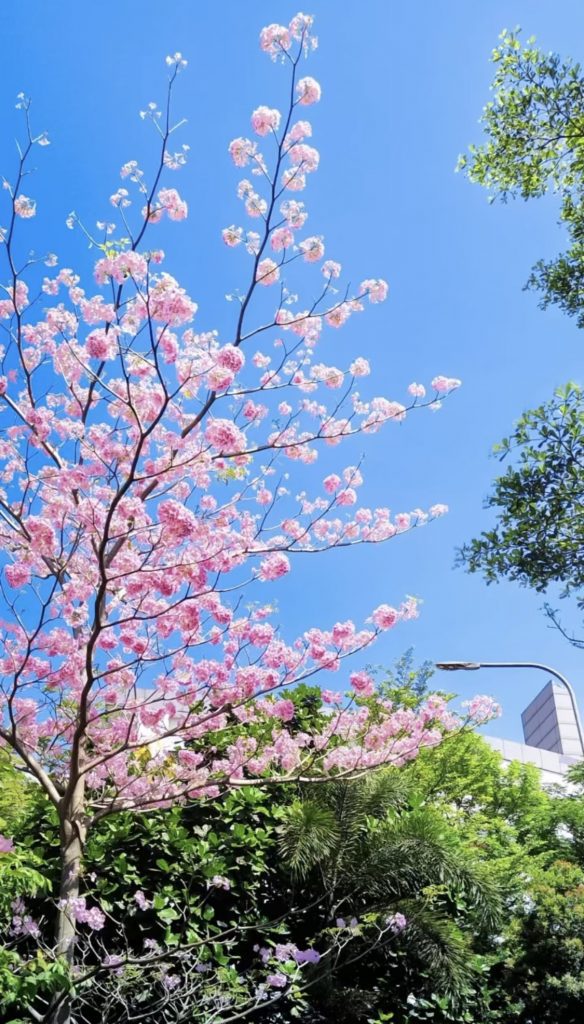
This variant is the most popular in Indonesia, especially because of its beauty that is similar to sakura. Pink tabebuya flowers are often found in university areas such as those at Telkom University, Housing, Urban or parks.
Yellow Tabebuya Flower
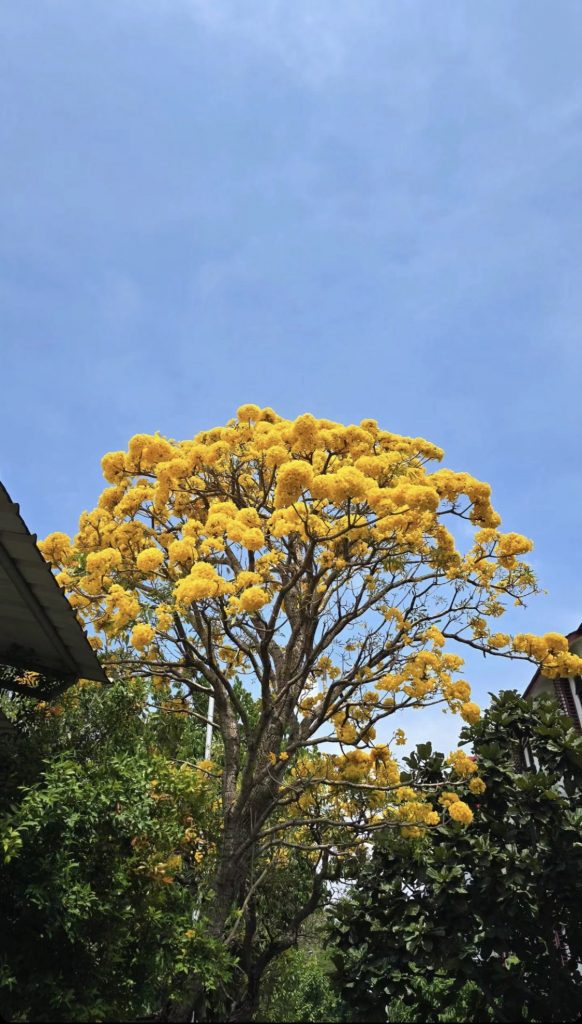
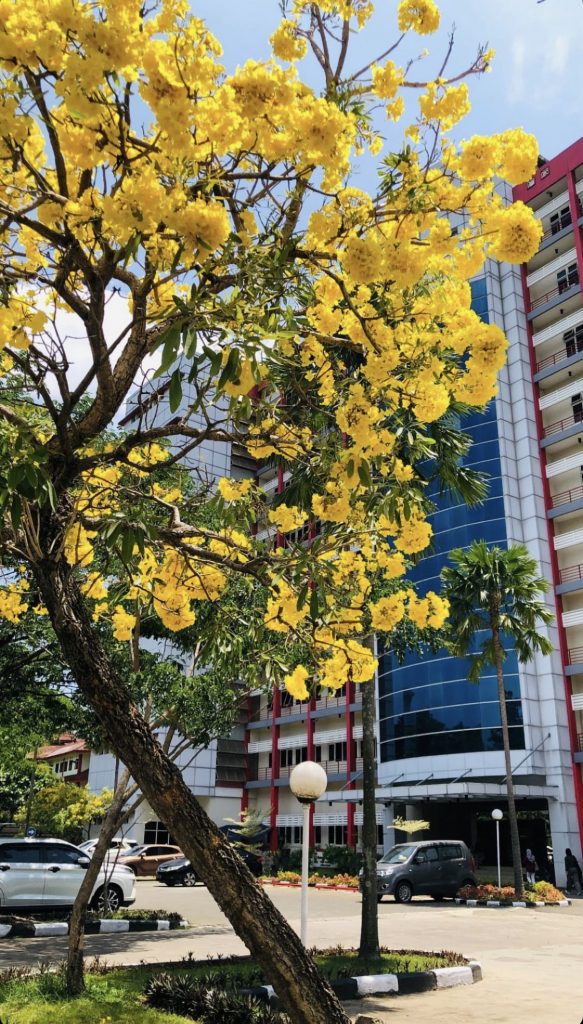
Yellow tabebuya flowers emit a bright yellow color that is very pleasing to the eye. Making this plant increasingly popular and in great demand today. This type of pink tabebuya flower can also be found in various corners of the Telkom University campus, we can see yellow tabebuya trees that grow well and provide cheerful colors to the campus environment.
White Tabebuya Flower
Although less popular in Indonesia. The white tabbebuya flower variant is also no less beautiful than the two types above. White tabebuya can give a peaceful and calm impression to increase the diversity of colors in the planted area.
Benefits of Planting Tabebuya on Campus
Did you know that besides being famous as an ornamental plant, the tabebuya tree can also be used as a medicine in several countries. According to research conducted by Seham S. El-Hawary, this plant is useful for treating malaria, syphilis, skin infections, stomach disorders, cancer and infections caused by bacteria or fungi. This treatment is obtained from the extraction of tabebuya tree bark.
Tabebuya tree extract contains napthoquinones, quinines, furanonapthoquinones, benzoic acid, cyclopentene dialdehyde and flavonoids which are believed to treat various health problems. Here are various health studies of the benefits of tabebuya in the health sector
| Study | Research result |
| Rao and Kingston, 1982 , Lubeck, 1998 , Alonso, 2004 , Zhang et al., 2015 | Tabebuya can be used as a traditional cancer treatment |
| Suo dan Yan, 2016 | Tabebuya can be used as a treatment for eczema, psoriasis, fungal infections, and even skin cancer. |
| Schultes and Raffauf, 1990 , Duke, 1985 , Duke and Vasquez, 1994 | Tabebuya can treat malaria, eishmaniasis, fever, fungal infections, bacteria and syphilis. |
| Lewis and colleagues, 2005 | Tabebuya can treat diabetes, malignant tumors, leukemia, other cancers, anemia, and Parkinson’s disease. |
The parts of the tabebuya tree that are often used as medicinal ingredients are the wood, bark, roots, leaves and flowers.
How to Plant and Care for Tabebuya Plants
For those of you who are interested in growing tabebuya at home or elsewhere, here are some steps you can take to plant and care for tabebuya plants.
Steps to Plant Tabebuya Trees
- Choose the Right Location: Tabebuia requires full sunlight to grow well. Make sure to plant it in an open area that gets direct sunlight.
- Prepare the Planting Media: Tabebuya can grow in various types of soil, but prefers loose soil with good drainage. Mix the soil with compost or organic fertilizer for best results.
- Planting Seedlings: After preparing a planting hole with a depth of about 30-50 cm, plant the tabebuya seedlings and cover them with soil. Make sure not to plant too deep, as the tabebuya roots need enough space to grow.
- Watering: Tabebuya does not require excessive watering. Watering can be done about one to two times a week, depending on the weather conditions. Try to keep the soil moist, but avoid excessive watering so that the soil becomes too wet.
Tabebuya Tree Care
Pruning: Light pruning can be done to maintain the shape of the tree and encourage more flower growth.
Fertilization: Applying organic fertilizer or compost every 3-4 months will help the tree grow and flower optimally.
Pest Control: Although tabebuia is fairly resistant to pests, it is important to check regularly to keep the tree healthy. Use natural insecticides if necessary.
The Uniqueness of Tabebuya Flowers in Indonesia
Although tabebuya is not native to Indonesia, this tree is apparently able to adapt well to the tropical climate that our country has. Several major cities in Indonesia, including Jakarta, Surabaya, and Bandung, have started planting tabebuya trees as part of urban greening.
Why is Tabebuya Getting More Popular?
- Sakura-like Aesthetics:
- Many call tabebuya as “Indonesian version of Sakura” because of its similar flower shape and colors that resemble cherry blossoms. This makes tabebuya a prime choice to beautify city parks.
- Easy to Treat:
- Tabebuya plants do not require complicated care, making them an ideal choice for those who want to grow ornamental trees without requiring a lot of effort.
- Various Color Options:
- The diversity of colors of tabebuya flowers, from pink, yellow, to white, adds to the beauty of gardens or green open spaces around us.
Telkom University and Greening Efforts with Tabebuya
Telkom University not only prioritizes academic achievement, but also pays full attention to environmental sustainability through movements Green Campus and student welfare. Through greening with tabebuya plants, this campus has succeeded in creating a more comfortable and aesthetic learning environment.
Environmental Initiatives at Telkom University
Some of the greening programs that have been carried out by Telkom University include:
Tabebuya Tree Planting: Every year, Telkom University increases the number of tabebuya trees in the campus area as part of an effort to maintain environmental sustainability.
Campus Park Management: In addition to tabebuya, Telkom University also plants various types of ornamental plants and other trees to maintain the balance of the campus ecosystem.
Conclusion
Tabebuya not only provides beauty with its striking flowers, but also has many benefits in improving environmental quality. At Telkom University, tabebuya trees have become a symbol of greenery and beauty of the campus. With various types of flowers such as pink and yellow, tabebuya is able to create a more natural and pleasant atmosphere in the learning environment.
Reference
El-Hawary, S. S., Taher, M. A., Amin, E., AbouZid, S. F., & Mohammed, R. (2021). Genus Tabebuia: A comprehensive review journey from past achievements to future perspectives. Arabian Journal of Chemistry, 14(4), 103046. https://doi.org/10.1016/j.arabjc.2021.103046
Author: Meilina Eka A – Directorate of Technology Center


Leave a Reply